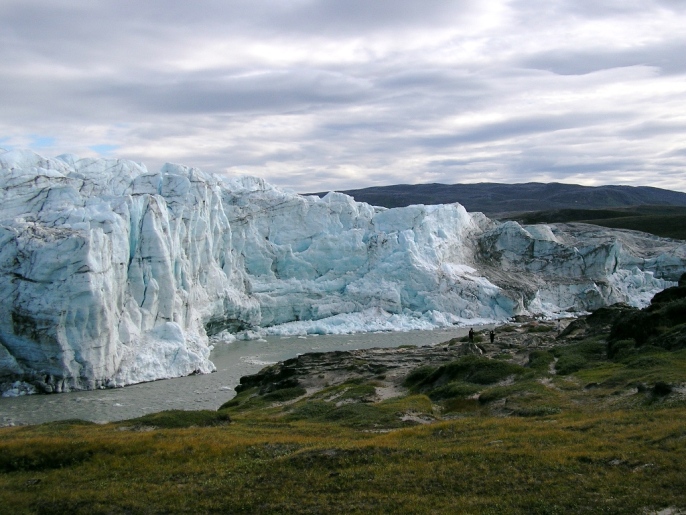Project Objective:
Create a comprehensive picture of Holocene climate and associated ecosystem distributions in western North America at specific temporal intervals since the last glacial maximum.
 There
is a certain excitement associated with recreating history. Understanding the world of the past has been and will continue to be a challenge for humanity. While looking forward can help us prepare for future events and develop technologies to improve the world, looking back can often provide similar insight.
There
is a certain excitement associated with recreating history. Understanding the world of the past has been and will continue to be a challenge for humanity. While looking forward can help us prepare for future events and develop technologies to improve the world, looking back can often provide similar insight.
The Holocene period, from ca. 21,000 years before the present (YBP) to the modern day is a fascinating time period. It saw some of the most recent shaping of the North American landscape, driven by massive climatic fluctuations. Oldfield (2003) describes the beginning of the Holocene as "denoting a major climate change that in turn triggered a whole sequence of responses in both abiotic and biotic ecosystem components." From an earth science perspective (regrettably), it doesn't get much sexier than that.
In the past 21,000 years, Canada has changed from a frozen, dry, and ice-covered landscape into the sweeping prairies, mountains, and forests that we see today. Key to these changes is the distribution of plant an trees species which has been altered dramatically in this period, largely due to climate changes (Williams 2002). From a geologic timescale perspective, these changes took place overnight and just in the last few pages of earth's history book. Possibly most interesting aspect of Holocene change is this relative recency.
In addition to the geologic and climatic study involved, there is a strong historical and archaeological interest in Holocene reconstructions. Potentially even prior to the last glacial maximum, people were migrating throughout North America (Rogers 1992). It is a rare occurrence in the earth sciences to be investigating a time period in which modern humans existed. For me, it adds a personal relevance to the research to know that individuals' lives were certainly affected by the geologic and atmospheric changes occurring throughout this period.
However, the study of the past has implications for the future also. Indeed, without a clear understanding of where the
earth has come from, it is challenging to determine, with any level of
certainty, where it is headed in the future. North America was a vastly different place 21,000 and even 6,000 years ago--from a climatic, vegetation, and ecosystem perspective. Due to the rapid environmental changes and the relatively intact records of fossils, tree rings, etc., this time period provides an excellent opportunity to better understand how plant communities respond to major climatic change. The implications of this understanding to future climate change scenarios and management cannot be understated, even while future climate scenarios are certain to be different in their specifics (especially with regard to atmospheric CO2, etc).
My research work in this field will focus on back-predicting the ecosystem distributions of these past time periods. Through this
investigation, two related questions will be investigated:
1)
Throughout the
Holocene, what were the climatic conditions in western North America?
2)
How did these
changing climatic conditions affect ecosystem distribution?
In order to answer
these questions, a comprehensive picture of Holocene climate and the associated
ecosystem distributions in western North America will have to be created.
Looking at this picture at specific temporal intervals since the last glacial
maximum (LGM)—namely at 6,000 and 21,000 YBP—will create a visual map of how
ecosystems change over time in response to dramatic climate fluctuations. This
investigation also has applications for modern climate and ecosystem
prediction.
Top of this page | Continue on to Project
References:
Gajewski, K. (1993). "The Role of Paleoecology in the Study of Global Climatic-Change." Review of Palaeobotany and Palynology 79(1-2): 141-151.
Guisan, A. and N. E. Zimmermann (2000). "Predictive habitat distribution models in ecology." Ecological Modelling 135(2-3): 147-186.
Hamann, A. and T. L. Wang (2005). "Models of climatic normals for genecology and climate change studies in British Columbia." Agricultural and Forest Meteorology 128(3-4): 211-221.
Jackson, S. T. and J. T. Overpeck (2000). "Responses of plant populations and communities to environmental changes of the late Quaternary." Paleobiology 26(4): 194-220.
Manly, B. F. J. (2005). Multivariate Statistical Mehtods: A Primer. 3rd Ed. Chapman & Hall / CRC Press, Boca Raton.
Oldfield, F. (2003) "The Holocene, A Special Time." in Global Change in the Holocene. Mackay, A., R. Battarbee, J. Birks and F. Oldfield, eds. Oxford University Press, New York.
Rogers, R. A., L. A. Rogers, et al. (1992). "How the Door Opened - the Peopling of the New-World." Human Biology 64(3): 281-302.
Webb, T. (1986). "Is Vegetation in Equilibrium with Climate - How to Interpret Late-Quaternary Pollen Data." Vegetatio 67(2): 75-91.
Williams, J. W., D. M. Post, et al. (2002). "Rapid and widespread vegetation responses to past climate change in the North Atlantic region." Geology 30(11): 971-974.
Williams, J. W. (2003). "Variations in tree cover in North America since the last glacial maximum." Global and Planetary Change 35(1-2): 1-23.
© 2007 - David Roberts, University of Alberta